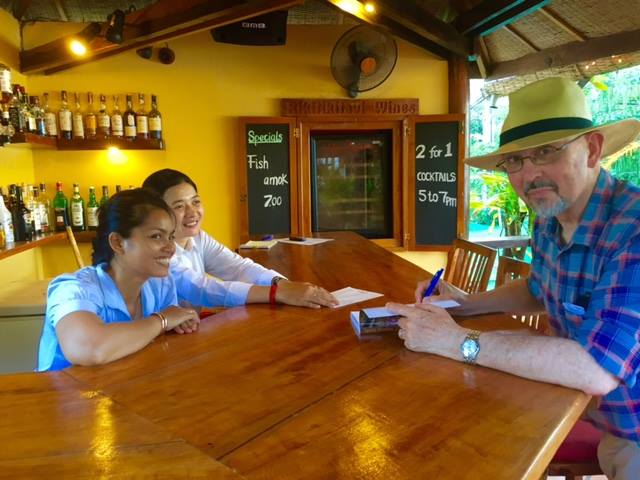Spirit Worlds by Philip Coggan (John Beaufoy Publishing 2015) is a spirit catching and spirit explaining book which also catches the eye. Being mindful of the Contents page of my non-fiction reads is not my normal practice. As I opened the cover of Spirit Worlds showing the Buddha image, found in the museum gallery at Angkor Wat, I took my time looking at and reading the two pages that outline the fourteen chapters of the 159-page book dealing with the spirit world, Buddhism, colonialism, and the monarchy. The book deals primarily with Cambodia although many countries are discussed for historical perspective, including India, Thailand, China, France, the USA, and Viet Nam. The Contents page includes six color photographs, which serve as a prelude to the over forty geographically unique color photos found throughout the book, including a dozen which are full-page in size.
With Chapter titles such as: The Buddha’s Tale; Domestic Gods; Tales from the Shadow World; The Dead; and, Inside the Crocodile, there was an initial temptation to jump around during the read, but that proved to be unnecessary. I read the book from cover to cover in three enjoyable sittings. Spirit Worlds is filled with interesting facts, passages and stories, as my now, much thicker than originally, dog-eared book will attest.
Spirit Worlds is factually written mainly about fascinating myths, superstitions, ghosts, life after death and religion. All religions have their myths and superstitions and dwell on the afterlife but what Coggan has done, in addition to including what would serve the novice well as a primer or refresher on Buddhism and life as a Buddhist Monk, is tell the reader the reality of the religion and the myths, while recapping the ideal, and the everyday ways that the spirit world is encrypted into Cambodian life (and death) – particularly Cambodian village life. Religion in Cambodia is blurry, as noted at the beginning of Chapter Two:
“Cambodian religion is a complex blend of Hinduism, Buddhism, and animism. Hinduism provides the Khmer with gods, Buddhism with an ethical framework, and animism a rich world of spirits. All three together make up the mandala of Cambodian spiritual life.” Spirit Worlds by Philip Coggan
Coggan explains Cambodian spiritual life in a variety of ways. For a picture filled book it is a dense read at times because it is so fact filled – the research done is evident, extensive, and impressive. First person accounts of the spirit world are told by common villagers and revered shamans alike to balance out the factual and historical citing’s, which when coupled with the color pictures makes for a smooth read.

Author and journalist Philip Coggan signing a copy of Spirit Worlds in Kampot
(Photograph by John Fengler)
My nit with the book is I wish the author had interjected his own presence more often, as he does in Chapter 9 – Earthly Powers, The Boramy’s Tale. Here we get one of the few true conversations. There is plenty of dialogue, but it tends to fly solo, without the benefit of a co-pilot.
One of my favorite chapters is Chapter 12 – The Four Faces: King Jayavarmin VII, King Ponhea Yat, King Norodom and King Sihanouk are discussed. I particularly enjoyed learning about King Sihanouk, his family and his ties to Thailand.
As I neared the end of Spirit Worlds the author seemed to be reading my mind. I was thinking how is he going to write about all these kindnesses, white magic (plus black magic) and superstitions without bringing up Pol Pot and the killing fields? Chapter 13 – an unlucky number in many western cultures – does this and does it well in a chapter which serves as a fulcrum for the book, propelling Cambodia into present day and its uncertain future. Inside the Crocodile discusses the crocodile years of Cambodia and answers the question of how a Buddhist country, which teaches non-violence and morality, could conceive of and follow-though on the execution of so many fellow Cambodians during the Khmer Rouge years. Cambodian civilization has survived the Khmer Rouge but certainly hasn’t thrived. As Coggan notes, “Today, it faces its greatest challenge ever: modernity.”
Daun Phann prepares an amulet – A lead plate inscribed with magic
Spirit Worlds – Cambodia, The Buddha and The Naga is chock-full of stories and story tellers much better than I can convey in this review. For all its compact size it is worthy of leaving out in plain sight. In its next larger incarnation, I could see it coming back as a hardcover coffee table book, hopefully with more stories directly involving the author. At $19.95 Spirit Worlds is not inexpensive. It does, however, offer good value, in an age of cheap books, for discerning readers and thoughtful gift givers looking for a spirited book about the living, the dead, and a Cambodian culture under siege.
Spirit Flag
This Review also published on December 23, 2015 in The Weekly for the Khmer Times




3 Responses to “Spirit Worlds by Philip Coggan – A Book Review”
Hoping to get my hands on a copy while in the region. Sounds brilliant!
[…] on Thailand Footprints. “Spirit Worlds by Philip Coggan (John Beaufoy Publishing 2015) is a spirit catching and […]
[…] his time between his home in Australia and travel in Asia. His books include Spirit Worlds reviewed here as well as a recent published history of Cambodia. He is best known as a friend of John […]